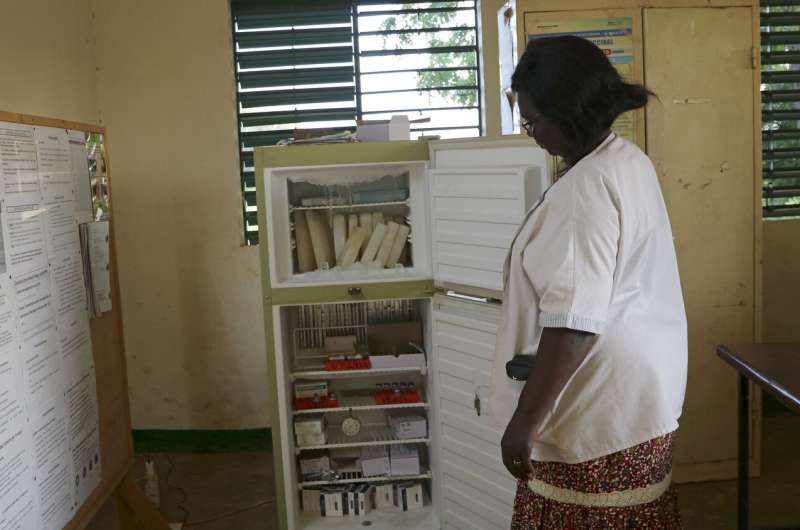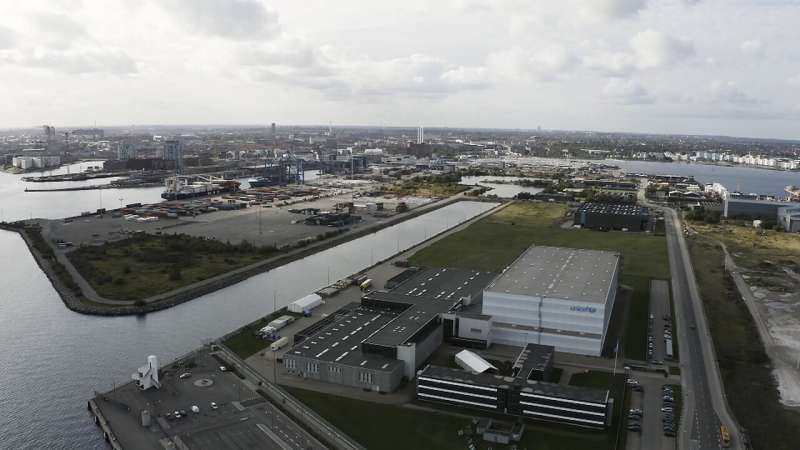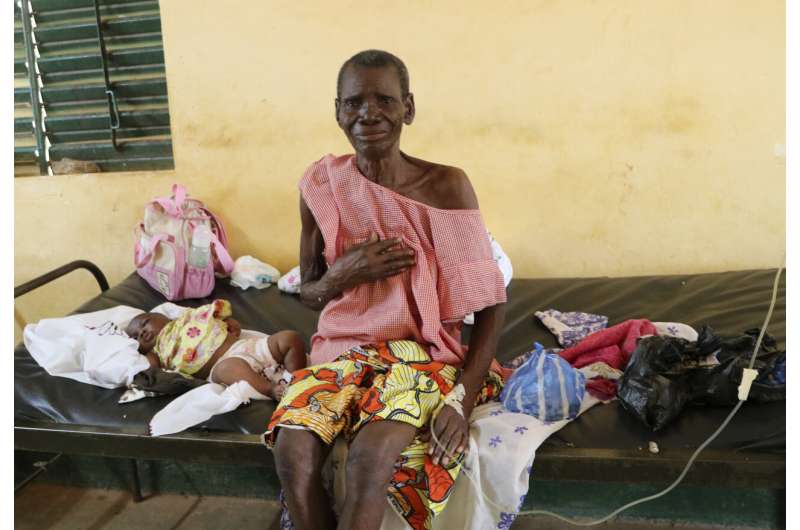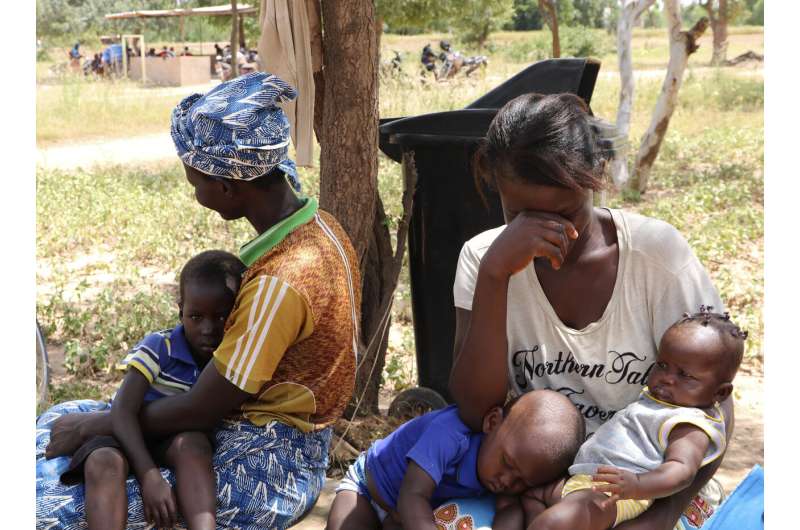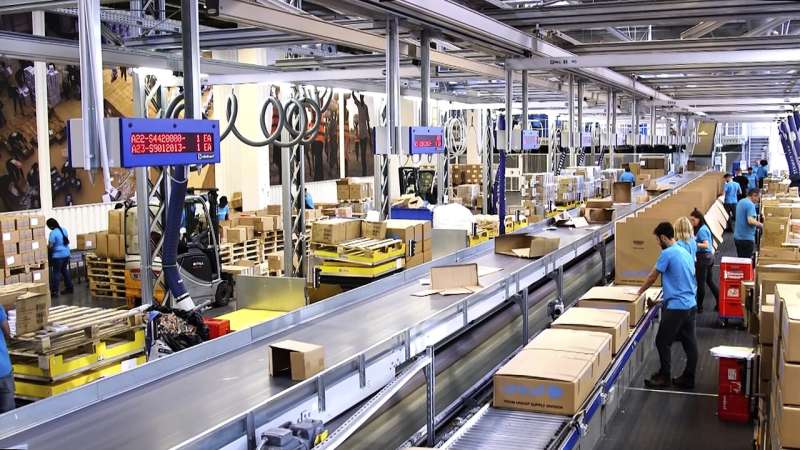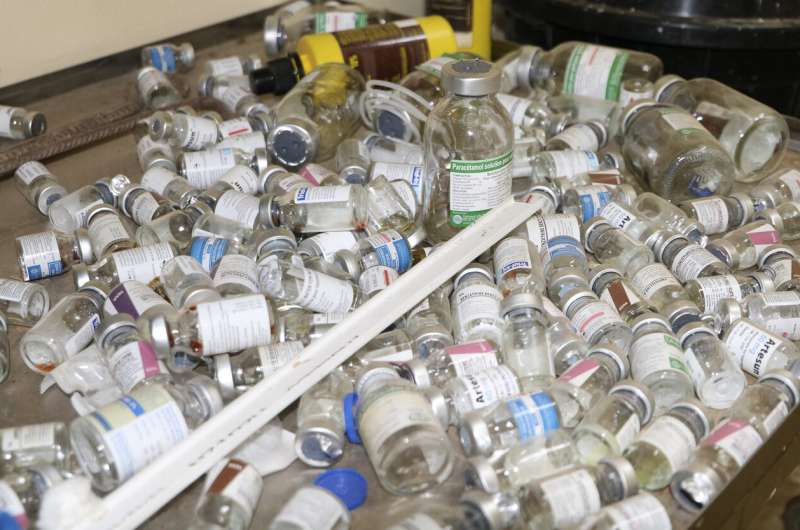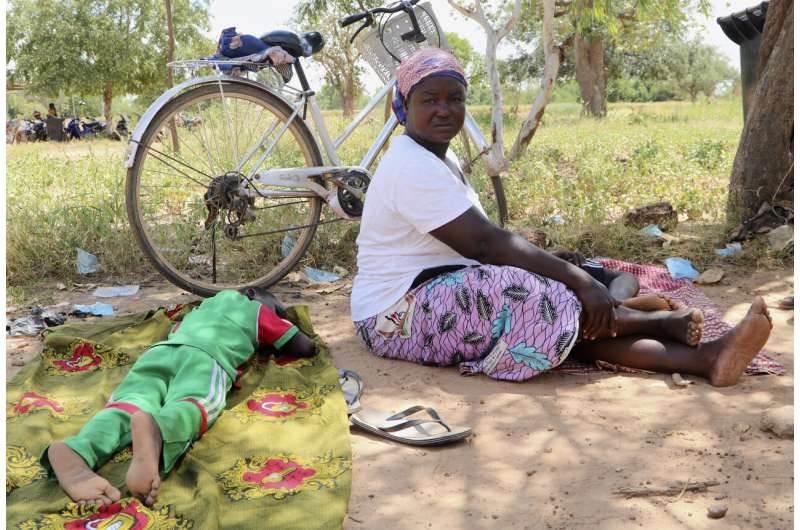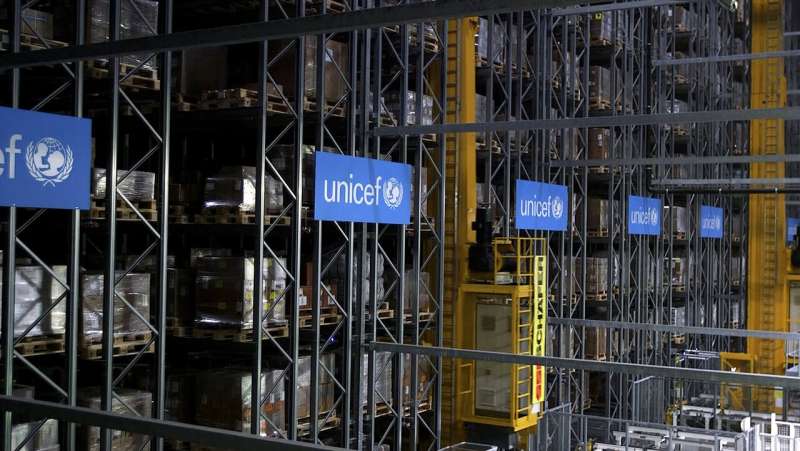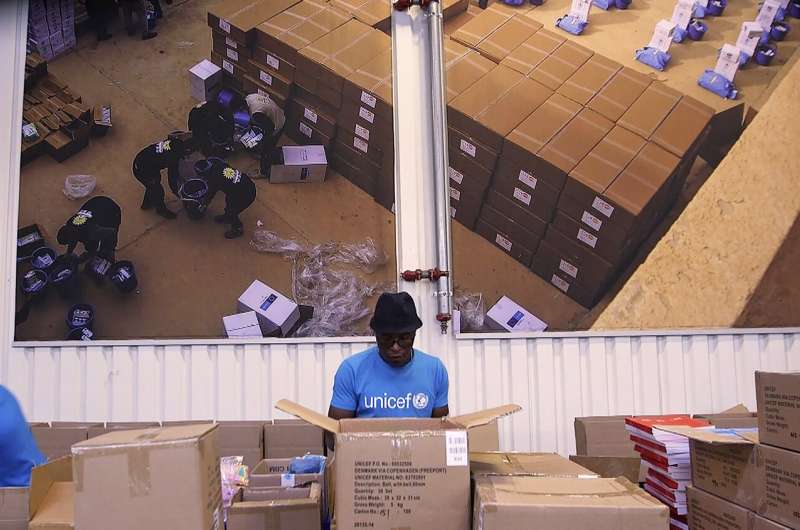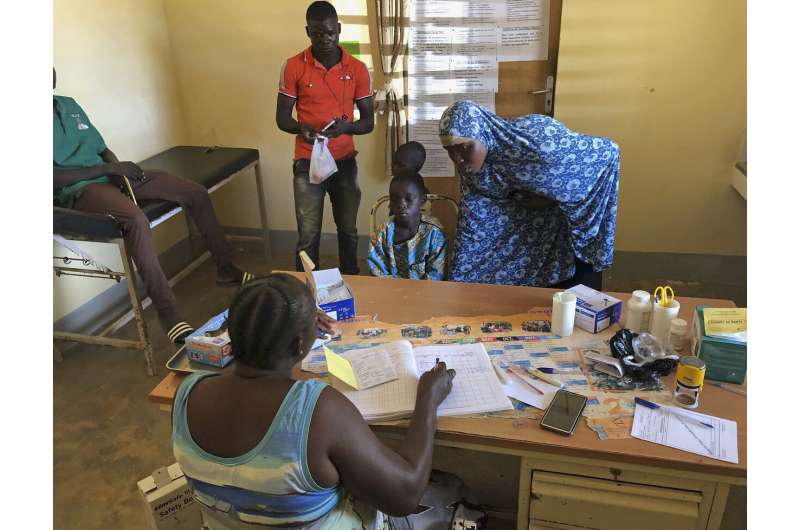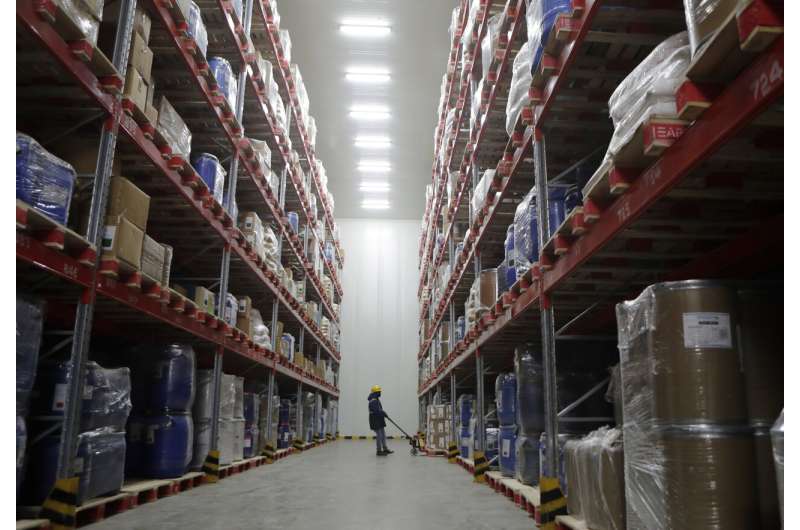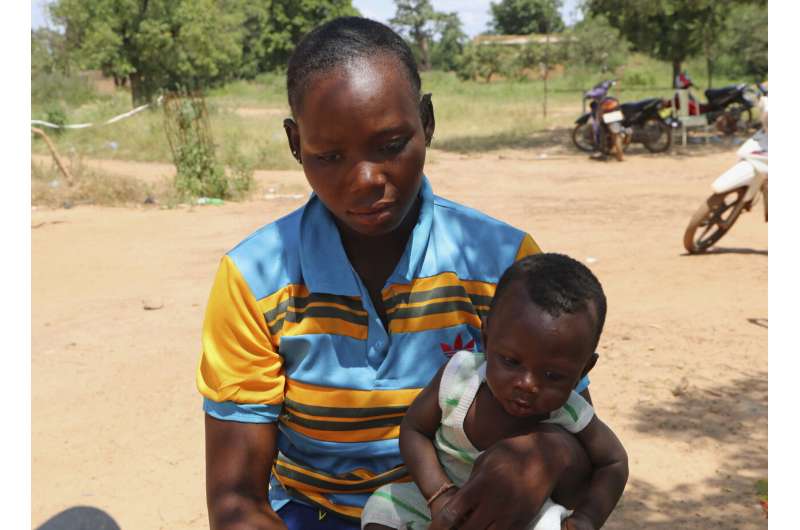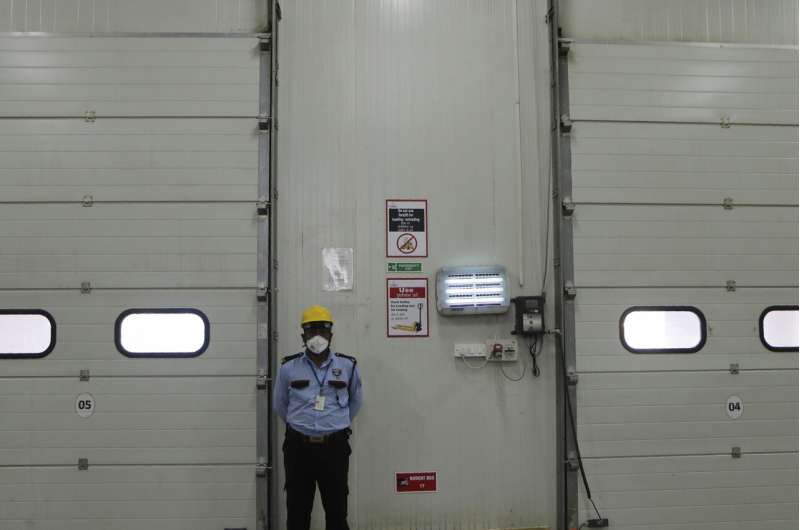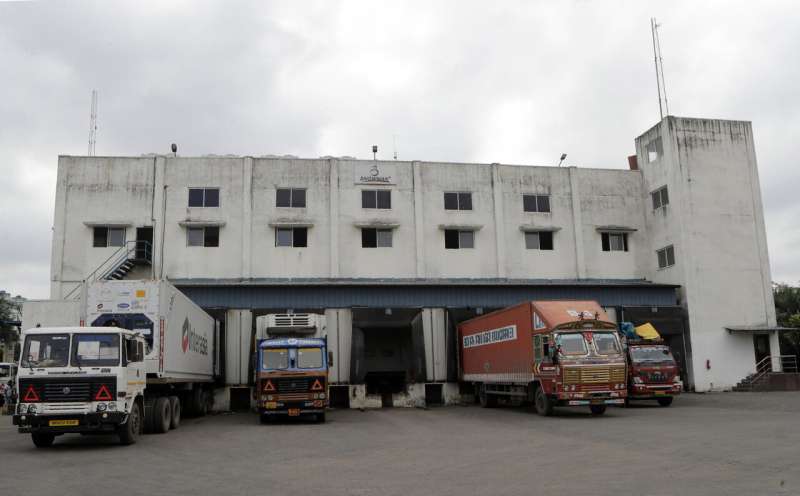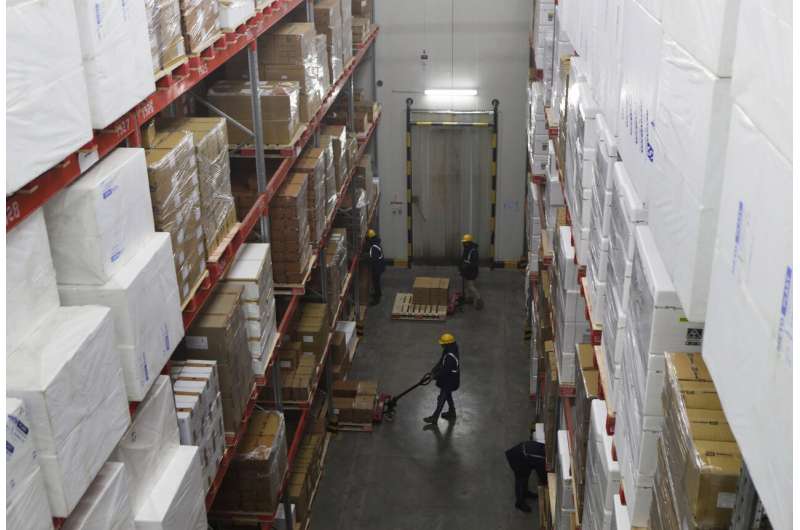Marguerite Ouangraoua, a nurse at the health clinic in Zeguedessin village on the outskirts of Burkina Faso's capital, Ouagadougou, opens the fridge where the clinic keeps the vaccines, Thursday Oct. 8, 2020. The vaccine cold chain hurdle is just the latest disparity of the pandemic weighted against the poor, who more often live and work in crowded conditions that allow the virus to spread, have little access to medical oxygen vital to COVID-19 treatment, and whose health systems lack labs, supplies or technicians to carry out large-scale testing. (AP Photo/Sam Mednick)
The chain breaks here, in a tiny medical clinic in Burkina Faso that went nearly a year without a working refrigerator.
From factory to syringe, the world's most promising coronavirus vaccine candidates need non-stop sterile refrigeration to stay potent and safe. But despite enormous strides in equipping developing countries to maintain the vaccine "cold chain," nearly 3 billion of the world's 7.8 billion people live where temperature-controlled storage is insufficient for an immunization campaign to bring COVID-19 under control.
The result: Poor people around the world who were among the hardest hit by the virus pandemic are also likely to be the last to recover from it.
The vaccine cold chain hurdle is just the lack labs, supplies or technicians to carry out large-scale testing.
Maintaining the cold chain for coronavirus vaccines won't be easy even in the richest of countries, especially when it comes to those that require ultracold temperatures of around minus 70 degrees Celsius (minus 94 F). Investment in infrastructure and cooling technology lags behind the high-speed leap that vaccine development has taken this year due to the virus.
Image taken from video showing an aerial view of the UNICEF warehouse, the world's largest humanitarian aid warehouse, in Copenhagen, Denmark, Tuesday Oct. 13, 2020. For Burkina Faso, India, Venezuela and other countries with shaky health care delivery systems, the best chance for receiving scarce supplies of a coronavirus vaccine is through the Covax initiative, led by the World Health Organization and the Gavi vaccine alliance. UNICEF began laying the groundwork months ago in Copenhagen, at the world's largest humanitarian aid warehouse. (AP Photo)
With the pandemic now in its eighth month, logistics experts warn that vast parts of the world lack the refrigeration to administer an effective vaccination program. This includes most of Central Asia, much of India and southeast Asia, Latin America except for the largest countries, and all but a tiny corner of Africa.
The medical clinic outside Burkina Faso's capital, a dirt-streaked building that serves a population of 11,000, is a microcosm of the obstacles.
After its refrigerator broke last fall, the clinic could no longer keep vaccines against tetanus, yellow fever, tuberculosis and other common diseases on site, nurse Julienne Zoungrana said. Staff instead used motorbikes to fetch vials in insulated carriers from a hospital in Ouagadougou, making a 40-minute round-trip drive on a narrow road that varies between dirt, gravel and pavement.
A woman sits on a bed in a small clinic in Zeguedessin village on the outskirts of Burkina Faso's capital, Ouagadougou, receiving medical treatment on Thursday Oct. 8, 2020. The hospital's solar fridge has been broken for a year meaning there is less space in the hospital to store large amounts of vaccines. The vaccine cold chain hurdle is just the latest disparity of the pandemic weighted against the poor, who more often live and work in crowded conditions that allow the virus to spread, have little access to medical oxygen vital to COVID-19 treatment, and whose health systems lack labs, supplies or technicians to carry out large-scale testing. (AP Photo/Sam Mednick)
A mother of two who visits the Gampela clinic says she thinks a coronavirus inoculation program will be challenging in her part of the world. Adama Tapsoba, 24, walks four hours under scorching sun to get her baby his routine immunizations and often waits hours more to see a doctor. A week earlier, her 5-month-old son had missed a scheduled shot because Tapsoba's daughter was sick and she could only bring one child on foot.
"It will be hard to get a (COVID-19) vaccine," Tapsoba said, bouncing her 5-month-old son on her lap outside the clinic. "People will have to wait at the hospital, and they might leave without getting it."
To uphold the cold chain in developing nations, international organizations have overseen the installation of tens of thousands of solar-powered vaccine refrigerators. Keeping vaccines at stable temperatures from the time they are made until they are given to patients also requires mobile refrigeration, reliable electricity, sound roads and, above all, advance planning.
Two women sit outside a small clinic in Gampela village on the outskirts of Burkina Faso's capital, Ouagadougou, Saturday Oct. 10, 2020, waiting to take their children to the doctor. They sometimes wait up to four hours to get medical help. The public health clinic responsible for serving approximately 11,000 people, did not have a working fridge for almost a year. The vaccine cold chain hurdle is just the latest disparity of the pandemic weighted against the poor, who more often live and work in crowded conditions that allow the virus to spread, have little access to medical oxygen vital to COVID-19 treatment, and whose health systems lack labs, supplies or technicians to carry out large-scale testing. (AP Photo/Sam Mednick)
For poor countries like Burkina Faso, the best chance of receiving a coronavirus vaccine is through the Covax initiative, led by the World Health Organization and the Gavi vaccine alliance. The learning from the past, especially the spring chaos surrounding global shortages of masks and other protective gear that were commandeered off airport tarmacs or stolen and traded on the black market.
Currently, 42 coronavirus vaccine candidates are in clinical trials and another 151 are in pre-clinical evaluation, according to WHO. The ones most likely to end up in the Covax mix must be stored at 2 to 8 degrees Celsius (26-46 F).
A Pfizer candidate is among the ones in advanced testing requiring storage at ultracold temperatures. The company, which has designed a special carrying case for its vaccine, has expressed interest in Covax and signed contracts with the United States, Europe and Japan.
Image taken from video shows people working inside the UNICEF warehouse, the world's largest humanitarian aid warehouse, in Copenhagen, Denmark , Tuesday Oct. 13, 2020. For Burkina Faso, India, Venezuela and other countries with shaky health care delivery systems, the best chance for receiving scarce supplies of a coronavirus vaccine is through the Covax initiative, led by the World Health Organization and the Gavi vaccine alliance. UNICEF began laying the groundwork months ago in Copenhagen, at the world's largest humanitarian aid warehouse. (AP Photo)
Medical freezers that go down to minus 70 degrees Celsius are rare even in U.S. and European hospitals. Many experts believe the West African countries that suffered through a 2014-16 Ebola outbreak may be the best positioned, because a vaccine against that virus also requires ultracold storage.
For more than two-thirds of the world, however, the advanced technology is nowhere on the horizon, according to a vaccines by drone. Indian officials have floated the idea of setting aside part of the country's vast food storage network for the coronavirus vaccines.
"If people can figure out how to transport ice cream, they can transport vaccines," Dai said.
Temperature-sensitive labels that change color when a vaccine is exposed to heat too long and no longer safe to use, and live delivery tracking to ensure vaccines reach their destinations as intended also have allowed for progress in delivering safe shots.
Empty vaccine bottles lie on a tray inside a small clinic in Gampela village on the outskirts of Burkina Faso's capital, Ouagadougou, Saturday Oct. 10, 2020. The public health clinic responsible for serving approximately 11,000 people, did not have a working fridge for almost a year. The vaccine cold chain hurdle is just the latest disparity of the pandemic weighted against the poor, who more often live and work in crowded conditions that allow the virus to spread, have little access to medical oxygen vital to COVID-19 treatment, and whose health systems lack labs, supplies or technicians to carry out large-scale testing. (AP Photo/Sam Mednick)
Yet chances for something to go wrong multiply on the ground as vaccines are prepped to leave national depots. Since the cold chain is so fragile, logistics planning is crucial; syringes and disposal boxes must be available as soon as vaccine shipments arrive.
By the end of the year, UNICEF expects to have an extreme example, but a coronavirus vaccine also is likely to test parts of Latin America with more robust health care systems. In Peru, private businesses that typically transport fish and beef have offered their trucks, though it remains unclear whether the Health Ministry will accept.
Back in Burkina Faso, vaccination days became an ordeal at the Gampela clinic when the refrigerator went out, said Zoungrana, the nurse. Staff members on hospital courier runs must buy fuel they often can't afford and make a second trip to and from the capital to return any unused doses.
A woman sits on the ground beside a sleeping child, outside a small clinic in Gampela village on the outskirts of Burkina Faso's capital, Ouagadougou, Saturday Oct. 10, 2020. People sometimes wait up to four hours to get medical help. The public health clinic responsible for serving approximately 11,000 people, did not have a working fridge for almost a year. The vaccine cold chain hurdle is just the latest disparity of the pandemic weighted against the poor, who more often live and work in crowded conditions that allow the virus to spread, have little access to medical oxygen vital to COVID-19 treatment, and whose health systems lack labs, supplies or technicians to carry out large-scale testing. (AP Photo/Sam Mednick)
"We're suffering," said Zoungrana, who was run off the road on her motorbike just a few weeks ago.
Days after journalists from The Associated Press visited the clinic this month, a long-awaited solar refrigerator arrived. With technicians in short supply, the clinic was waiting to be sure the appliance would function properly before stocking it with vaccines.
Nationwide, Burkina Faso is about 1,000 clinical refrigerators short, and less than 40% of the health facilities that conduct vaccinations have reliable fridges, national vaccination director Issa Ouedraogo said.
Multi-dose vials—the equivalent of bulk storage for vaccines—can drastically reduce global transportation costs. But once a vial is opened, its shelf life counts down even faster; if too few people show up for their jabs in time, whatever remains in the larger vials must be discarded.
-
This image taken from video shows the inside of the UNICEF warehouse, the world's largest humanitarian aid warehouse, in Copenhagen, Denmark , Tuesday Oct. 13, 2020. For Burkina Faso, India, Venezuela and other countries with shaky health care delivery systems, the best chance for receiving scarce supplies of a coronavirus vaccine is through the Covax initiative, led by the World Health Organization and the Gavi vaccine alliance. UNICEF began laying the groundwork months ago in Copenhagen, at the world's largest humanitarian aid warehouse. (AP Photo)
-
This image taken from video shows people working inside the UNICEF warehouse, the world's largest humanitarian aid warehouse, in Copenhagen, Denmark , Tuesday Oct. 13, 2020. For Burkina Faso, India, Venezuela and other countries with shaky health care delivery systems, the best chance for receiving scarce supplies of a coronavirus vaccine is through the Covax initiative, led by the World Health Organization and the Gavi vaccine alliance. UNICEF began laying the groundwork months ago in Copenhagen, at the world's largest humanitarian aid warehouse. (AP Photo)
-
A boy sits in a chair and speaks to a nurse at a small clinic in Gampela village on the outskirts of Burkina Faso's capital, Ouagadougou on Saturday Oct. 10, 2020. The public health clinic responsible for serving approximately 11,000 people, did not have a working fridge for almost a year. The vaccine cold chain hurdle is just the latest disparity of the pandemic weighted against the poor, who more often live and work in crowded conditions that allow the virus to spread, have little access to medical oxygen vital to COVID-19 treatment, and whose health systems lack labs, supplies or technicians to carry out large-scale testing. (AP Photo/Sam Mednick)
-
A worker moves boxes at Snowman Logistics, India's largest cold storage company in Taloja, on the outskirts of Mumbai, India, Saturday, Oct. 17, 2020. The vaccine cold chain hurdle is just the latest disparity of the pandemic weighted against the poor, who more often live and work in crowded conditions that allow the virus to spread, have little access to medical oxygen vital to COVID-19 treatment, and whose health systems lack labs, supplies or technicians to carry out large-scale testing. (AP Photo/Rajanish Kakade)
-
Adama Tapsoba sits with her child on her lap outside a small clinic in Gampela village on the outskirts of Burkina Faso's capital, Ouagadougou, Saturday Oct. 10, 2020. Tapsoba walks four hours under scorching sun to reach the Gampela clinic and waits another four hours for her 5-month-old son to get his routine baby immunizations. She says she thinks that participating in a widespread coronavirus inoculation program will be challenging in her part of the world. The public health clinic responsible for serving approximately 11,000 people, did not have a working fridge for almost a year. (AP Photo/Sam Mednick)
-
A security guard stands by at Snowman Logistics, India's largest cold storage company in Taloja on the outskirts of Mumbai, India, Saturday, Oct. 17, 2020. The vaccine cold chain hurdle is just the latest disparity of the pandemic weighted against the poor, who more often live and work in crowded conditions that allow the virus to spread, have little access to medical oxygen vital to COVID-19 treatment, and whose health systems lack labs, supplies or technicians to carry out large-scale testing. (AP Photo/Rajanish Kakade)
-
Trucks parked outside Snowman Logistics, India's largest cold storage company in Taloja, outskirts of Mumbai, India, Saturday, Oct. 17, 2020. The vaccine cold chain hurdle is just the latest disparity of the pandemic weighted against the poor, who more often live and work in crowded conditions that allow the virus to spread, have little access to medical oxygen vital to COVID-19 treatment, and whose health systems lack labs, supplies or technicians to carry out large-scale testing. (AP Photo/Rajanish Kakade)
-
Workers move boxes inside Snowman Logistics, India's largest cold storage company in Taloja on the outskirts of Mumbai, India, Saturday, Oct. 17, 2020. The vaccine cold chain hurdle is just the latest disparity of the pandemic weighted against the poor, who more often live and work in crowded conditions that allow the virus to spread, have little access to medical oxygen vital to COVID-19 treatment, and whose health systems lack labs, supplies or technicians to carry out large-scale testing. (AP Photo/Rajanish Kakade)
"It's really upsetting to have wastage like that. It'll result in loss of lives and pain and suffering. It's a waste of resources, " said University of Massachusetts at Amherst professor Anna Nagurney, who studies supply chain logistics.
For now, UNICEF is betting on 20-dose vials of coronavirus vaccine and hoping that the amount wasted will stay below 3% for closed vials and 15% for open multi-dose vials that do not get used up, according to Michelle Siedel, one of the U.N. agency's cold chain experts.
If Burkina Faso were given 1 million doses of a coronavirus vaccine today, the country wouldn't be able to handle it, Jean-Claude Mubalama, UNICEF's head of health and nutrition for the African nation.
"If we had to vaccinate against the coronavirus now, at this moment, it would be impossible," he said.
© 2020 The Associated Press. All rights reserved. This material may not be published, broadcast, rewritten or redistributed without permission.
